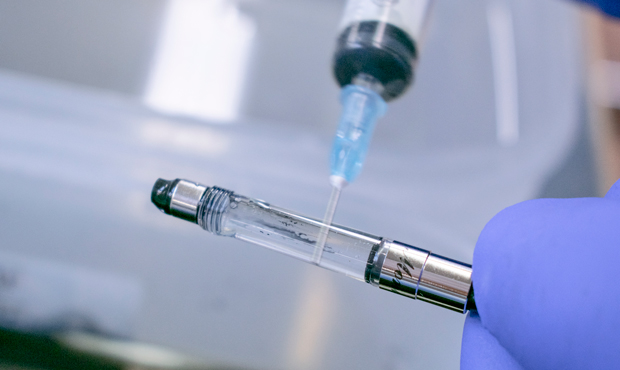- Continue Shopping
- Your Cart is Empty
How to clean a fountain pen
Tips for perfect care
“When held between the fingers, a pen is a source of pleasure. When laid down, it gives satisfaction. It brings value not only to those who use it, but also to others – often far away and sometimes separated by thousands of years."
F.Petrarca
So wrote Francesco Petrarch in his Epistles
while overcome by the power and pleasure of writing
Many of us know the sense of reward that comes from holding a fountain pen. Admiring its elegant fusion of form and function only heightens the pleasure of committing thoughts to paper.
But to ensure that writing experiences remain pleasurable, regular and correct fountain pen maintenance is required.
Whenever your fountain pen does not write well, it could be dirty or clogged. Periodic cleaning is needed to eliminate dry ink and other residues that accumulate with normal use.
By learning the best way to clean a fountain pen, you can ensure your writing companion will enjoy a long and fruitful life. Let’s find out how.
CLEANING FOUNTAIN PENS
The importance of good routine
Whenever a fountain pen does not write well – despite being fully charged with ink – the nib is most likely the problem. Nib cleaning is recommended every time you refill your pen or replace a cartridge.
Cleaning nibs requires you to disassemble your pen by unscrewing the barrel from the grip section. During disassembly, pay special attention to the ink cartridge: the small disposable tank that sends ink flowing towards the nib. During cleaning, keep the pen in a vertical position – ideally using a pen stand or case.
If your pen is equipped with a converter, gently remove it from the body. A converter is a reusable ink reservoir that can be refilled from a bottle.
CLEANING NIBS
Just add water

Rinse the nib by allowing lukewarm, running water to flow through it. Hold it upright under a gently running tap, or use a syringe to inject small amounts of water into the tip. Water must always be clean and lukewarm: high temperatures can damage internal components.
Continue rinsing until the water runs clear and you can see no signs of residual ink. To remove stubborn residues of dried or encrusted ink, leave the nib to soak overnight in a solution of vinegar and water. A concentration of 5 ml to 250 ml is recommended.
Allow the nib to dry, then shake a couple of times to remove any remaining water. Then leave it overnight in a well aired location, placing it in an upright position.
CLEANING CONVERTERS
Delicate, but necessary

Fountain pens fitted with converters require extra cleaning. Once the converter has been removed from the pen, empty any remaining ink – taking care not to stain clothes or other surfaces. Use a syringe to rinse it with lukewarm water, always applying moderate pressure: too much pressure can lead to water accumulating beneath the piston gasket, resulting in stubborn coagulation.
Fill the converter with water, then seal it and shake it vigorously to dislodge any residual ink. Rinse it again until it runs clear, and then leave it to dry overnight by placing it on a paper towel. For thorough drying, stand the converter vertically. Using a paper towel will help absorb any remaining moisture.
Cleaning the converter is a delicate process, but one that helps keep your fountain pen – and your writing – at the top of its game.
SURFACE CLEANING
Clean and shiny!

Most fountain pen owners want their writing companion not only to perform at its best, but also look the part. Keeping fountain pens clean and shiny can be a joyful experience, but doing it the right way depends on the materials they are made from.
Fountain pens made of sterling silver or silver-plate should be cleaned with silver polish and a soft cloth. For intricate engravings and fretwork found on top-tier pens, dirt and tarnishing can be removed with a silver brush or a soft toothbrush.
A soft cloth is usually all that is needed to clean pens with hard-metal finishes like platinum, palladium, stainless steel or chrome. Soft cloths are also recommended for pens made of celluloid, enamel or resin. For sensitive finishes like these, it is very important to avoid use of all chemicals or abrasives.

TIPS FOR STORING FOUNTAIN PENS
Prevention and protection
To prevent a fountain pen from drying out, always remember to keep it capped when not in use. Leaving it standing vertical in a case or on a pen stand will help it reach peak performance more quickly. Vertical stowing also helps prevent ink from drying within the nib and feed.
It is advisable to remove all ink before leaving your fountain pen idle for longer periods. If a pen is left resting for a long time while inked, acids within the ink can react to the air and result in oxidisation on the nib.
Once emptied, fountain pens can be stored either vertically or horizontally. Use a pouch or case to keep them in pristine condition.
By following these habits and routines, Montegrappa fountain pens will stay in excellent shape: always primed to provide the joyful writing performance assured by Italian artisanal tradition.

GET IN TOUCH
- 01245 225775
- Horseshoe Barn, Main Road, Bicknacre, Chelmsford, Essex, CM3 4EX
- info@montegrappa.co.uk
